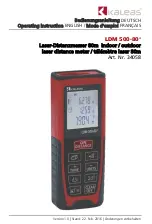
15
b
AttEriEs
r
EpLACEmEnt
This meter has been designed for use with both alkaline
and rechargeable Nickel Metal Hydride (NiMH) batteries.
No other types are recommended. The analyzer is supplied
with 4 “AA” size alkaline batteries.
These should be installed into the instrument as shown
in the diagram to the right and indicated on the back of
the unit.
CAUTION!
Take great care when installing the batteries to observe
correct polarity. Always check the meter for operation
immediately after installing new batteries.
U
sinG
r
E
-C
hArGEAbLE
b
AttEriEs
The battery charger must only be used when NiMH batteries are fitted. Alkaline batteries
are not
re-chargeable. Attempting to recharge alkaline batteries may result in damage to the product and may
create a fire risk.
b
AttEry
C
hArGinG
Ensure that you use the correct charger. This unit uses a 9V DC regulated charger.
Ensure that the batteries are fitted in the correct manner, and then charge for at least 16 hours. Subsequent
charges should be overnight. NiMH batteries may be charged at any time, even for short periods to
conduct testing.
WARNING!
Under NO circumstance should you expose batteries to extreme heat or fire as they may explode and cause
injury. Always dispose of old batteries promptly in a manner consistent with local disposal regulations.
E
LECtrOmAGnEtiC
C
OmpAtibiLity
(EmC)
This product has been tested for compliance with the following generic standards:
EN 50081-1, EN 50082-1 and is certified to be compliant.
The European Council Directive 89/336/EEC requires that electronic equipment does not generate
electromagnetic disturbances that exceed defined levels and has an adequate level of immunity to enable it to
be operated as intended.
Since there are many electrical products in use that pre-date this Directive and may emit electromagnetic
radiation in excess of the standards defined in the Directive there may be occasions where it would be
appropriate to check the analyzer prior to use. The following procedure should be adopted.
• Go through the normal start up sequence in the location where the equipment is to be used
• Switch on all localized electrical equipment that might be capable of causing interference
• Check that all readings are as expected (a level of disturbance in the readings is acceptable)
• If not, adjust the position of the instrument to minimize interference or switch off, if possible, the
offending equipment for the duration of the test
At the time of writing this manual (July 2009) UEi is not aware of any field based situation where such
interference has ever occurred and this advice is only given to satisfy the requirements of the Directive.
Note: Follow battery
directions on back of
housing
Battery Compartment
Cover
Back of
Instrument
C75 Directions
C125/C127, C155/C157
Directions
OR


































